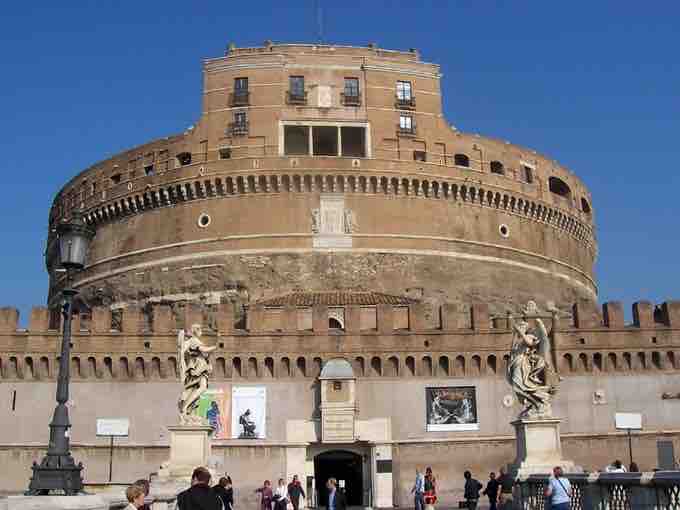Like Trajan before him, the emperor Hadrian had a long and successful career as an emperor of Rome, reigning from 117 to 138 CE.
Hadrian's time as emperor was marked with peace and relative stability throughout the empire. He was an active general in the military, both before and after becoming emperor, despite a lull in military conflicts during his reign. He worked to strengthen Rome's borders by building fortifications, outposts, and walls. The most famous of these is Hadrian's Wall in Britainnia that marked the northern boundary of the empire on the isle. Hadrian also traveled extensively, enjoying new cultures, inspecting troops, and promoting military readiness.
Ostia
During Hadrian's reign, the port city of Ostia grew significantly, reaching over 75,000 inhabitants by the third century CE. Located at the mouth of the Tiber on the Tyrrhenian Sea, Ostia was the main port city of Rome. The city was first founded during the third century BCE, as one of Rome's earliest colonies. The ruins of Ostia are from the city's imperial period when it was at the height of its prosperity. Since Rome was settled inland, Ostia was always an important component to the capital city, especially as the empire expanded and relied on its provinces for survival. Merchant vessels and large ships filled with grains, building materials, and other goods to sell in Rome docked at Ostia, where the goods were eventually transferred upriver.
Insulae
Ostia was a typical of a Roman city, including a large central forum, bath houses, temples, a theatre, barracks for firemen, and apartment buildings. The two central streets of the city, the cardo and decumanus ran north-south and east-west through the city, intersecting at the forum–the center of the city's civic and religious activities. Citizens of Ostia lived in apartment houses or insulae, which stood six or seven stories high. The insulae of Ostia demonstrate the cramped and noisy living style that was common in Roman cities. Shops, known as tabernae, occupied the ground level of the insulae, while the upper stories housed apartments. Roman apartments varied in size from larger homes located on the lower floors with private dining and cooking areas, as well as private toilets to small cramped rooms with communal cooking areas and toilets on the upper floors.
Insulae at Ostia.
Insulae, or apartment blocks, in the city of Ostia.
Religion
Excavations at Ostia reveal a variety of temples and meeting sites for cults and rituals. This reflects the relative religious diversity within the Roman Empire. Common features throughout the Empire include the Capitolium, the temple dedicated to Jupiter, Juno, and Minerva, in the forum at the center of the city. Across from the Capitolium in the forum stands a temple dedicated to Augustus and Roma. Within close proximity is the Temple to Hercules, and throughout the city are temples dedicated to gods related to shipping and commerce, as well temples built by guilds, such as the ship builders or the rope makers, for their patron gods. On the city's outskirts, there is also a large sanctuary to the goddess Cybele or Magna Mater, attesting to her popularity in the city. The god Mithras was also popular among the Ostians and worshiped solely by men in the form of a mystery cult. Over 15 mithraea have been discovered in the city. These mithraea are nearly all built underground to replicate the cave central to the myths of Mithras. Hadrian's general religious tolerance is reflected in this religious diversity, including the presence of a Jewish synagogue.
The Capitolium at Ostia.
The Arch of Trajan at Benevento
The Arch of Trajan in Benevento draws visual cues from the Arch of Titus at Rome. This arch, built between 114 and 117 CE, was erected over the Via Appia, one of Rome's most ancient roads through southern Italy, as the road entered Beneventum. Like the Arch of Titus, the Arch of Trajan is ornately decorated with scenes of conquest and the deeds completed by Trajan. On both sides of the arch is a dedicatory inscription. The exterior is decorated with engaged columns and reliefs of Trajan's military conquest of Dacia, the extent of the Roman empire, and allegorical scenes of imperial power as well as Trajan's good deeds as both a builder of public works and as the founder of a charitable institution for children in Roman Italy.
The Arch of Trajan at Benevento (ancient Beneventum).
View from the north. Benevento, Italy. 114-117 CE.
The two interior relief panels depict the religious activity of Trajan. One shows him making a sacrifice in one of Rome's oldest forum the Forum Boarium, which was home of some of the city's oldest temples. The other panel depicts Trajan being welcomed after his apotheosis by the Capitoline Triad. These two scenes depict Trajan's piety as well as the approval given him by the three most important gods in the Roman pantheon.
Hadrian's Mausoleum
Hadrian also built a large mausoleum for himself and his family on the right bank of the Tiber River in Rome. Its original design seems to have purposely recalled the Mausoleum of Augustus, located across the river on the Campus Martius. The Mausoleum of Hadrian was a large cylinder topped by a garden and quadriga statue. A central room housed the ashes of Hadrian and his family, as well as several of the emperors who succeeded him. While Hadrian's Mausoleum still stands today, it was later converted into a residence and fortress under the Roman popes and now serves as a museum.

Hadrian's Mausoleum as it stands today.
The Mausoleum of Hadrian was a large cylinder topped by a garden and quadriga statue. A central room housed the ashes of Hadrian and his family, as well as several of the emperors who succeeded him.